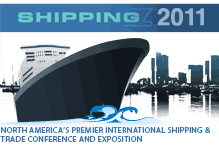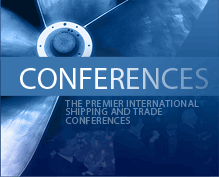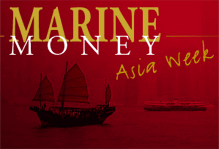
Marine Money Week –Let the Games Begin!
By Matt McCleery
For the past 16 years, Marine Money has had the privilege of introducing the world’s best marine transportation companies to the US Capital Markets and, judging from this year’s 16th annual Marine Money Week, the relationship has never been better. The level of professionalism exhibited by the public shipping companies, coupled with the strong support of industry players and increased investor interest, are coming together to help shipping and the capital markets to turn an important corner – an expansion of valuation multiples that will accelerate consolidation in a way that we have never before witnessed. The sophistication of the presentations was also unprecedented. Lest anyone forget that just a few years ago Teekay overwhelmed the audience with its risk management sophistication by presenting a slide that showed the impact on EPS of each $1,000 move in freight rates – a slide that has become downright tawdry these days!
There is no doubt that we are working in exciting times, and the mood at this year’s event was one of people positioning themselves and their businesses for the new era that is being ushered in. On a more practical level, Marine Money Week often marks the beginning of a slow summer season for deals, but judging from conversations on the dais, in the hallways and during the cocktail parties and dinners, it has not been a surprise to find the 3rd quarter of 2003 as busy as the first two.
Before reviewing the event for those who were unable to attend, I would like to say thanks – to our speakers for their time and energy and professionalism; to our sponsors for being so supportive of what we do and for being such gracious hosts to all of our visitors in New York; to our chairmen, Craig Fuehrer of JP Morgan, Morten Arntzen of AMA and Magnus Fyhr of Jefferies and John Karen of Deloitte & Touche for guiding the long days and managing the tight schedule; to our Events Director Ms. Lorraine Parsons for pulling together a million details; and of course, to the 400 delegates who attended this year. Although 2003 has been a turbulent year politically and economically, the overwhelming response to the event is proof that a healthy market for shipping deals has once again triumphed over all else – a fact that should be both comforting and gratifying to all of us who make our living in the industry.
Introducing Marine Money’s Quarterly Peer Analysis
By Prasanth Prasannakumar
“Who’s making money?” That’s the question we set out to answer in this issue of Marine Money. And it’s a very good segue to the introduction of Marine Money’s quarterly Peer Analysis, an update on our annual Rankings. We have tried to make the list as comprehensive as possible by including all companies which provided us with current financials, but many companies located outside the US are still missing. Our goal is to continue to widen our coverage so as to offer a segment-by-segment analysis; we hope it will enable you to ascertain how your public or private company compares to its competition. Moreover, given the volatility of the shipping markets and the often short- term time horizon of investors, a firm’s performance can vary from quarter to quarter.
Marine Money thinks that total return to shareholders is probably the most vital benchmark when it comes to investors. After all, investors want to see higher dividend yields and capital appreciation. Eventually the market will reward those companies that create wealth for public shareholders, not just insiders. In our quarterly update, we have highlighted what each stock would have returned on a quarterly basis for the first two quarters of 2003.
EarnIngS Per Share
Earnings Per Share (EPS) is the diluted earnings per share appearing on the company’s income statement.
Bonus Time?
By Matt McCleery
Who’s making what? That’s the rather blunt question we ask and attempt to answer in this issue of Marine Money. In this article, we will take a quick look at compensation for public and private shipping companies, as well as bankers. Like many of the articles in Marine Money, the pictures that accompany this text are wrote a thousand words.
As you can see, the data included herewith comes from a variety of sources. The salary information relating to largely private companies was drawn from the CEO/CFO confidential survey that we conducted in partnership with Deloitte & Touche. The survey, which was concluded in June, included medium- and large-sized marine companies with revenues ranging from less than $100 million to more than a $1 billion. The majority of the companies we surveyed were private.
In addition, we also include the executive compensation at publicly traded marine companies. This data was drawn from public filings and was compiled by executive recruiter Korn Ferry International in New York, which specializes in executive level recruiting in the marine and marine finance industries.
CMB/EXMAR – IN FOCUS
By Andreas Vergottis
The CMB group has witnessed plenty of transaction activity since 1991 when the Saverys family acquired control. At first, such activity was rather opportunistic and some might even say “random.” More recently, CMB’s transactions have been placed under a disciplined strategic framework providing a long term direction towards increased rationalization of activities. A landmark event is the recent demerger of the gas activities from the bulk and tanker operations. In this article, we review the benefits of the transaction activities of CMB, particularly the benefits of the most recent demerger, and conclude that the best may be yet to come for investors in the offshoots of the recent demerger.
CORPORATE EVENT
On Monday June 23rd, with the blessing of an extraordinary general meeting of CMB shareholders held the week before, Exmar was demerged from its parent, resulting in the creation of two separate entities with individually listed shares: Exmar and the remainder of CMB. The activities of the two companies are summarised in the demerger summary below.
The advisors to the transaction were Fortis Bank and UBS, while the brokers were Belgian house Petercam, Fortis Bank and KBC.
Who’s Making Money?
“Hey, McCleery,” the old man whispers in a way that makes me feel like what he is about to say is illegal. “Tell me, who’s making the money these days?” No “Hello”, no “How’s the family?” – no nothing. All I hear is the same question I hear a few times every year from a grumbling veteran Norwegian investor who only half-follows the sector these days. “Well…” I begin, but immediately he interrupts me. “Don’t give me any of that horseshit about the fundamentals or new regulations; just tell me who’s making the money.” If I don’t answer immediately, I will lose him because, like many equity investors, his attention span is decidedly short.
This issue of Marine Money is dedicated to my impatient friend. Although it may sound like a vulgar question to some, it would be naïve to think that “who’s making the money” is not a question that is constantly on the minds of most players in the maritime industry – be they shipowners, investors, shipyards or bankers. Money is not only what we use to support our families and ourselves, it is also a validation that what we are doing is being accepted by the marketplace has having some value. And at times, of course, the more operative question is whether anyone is making any money at all; after all, an equity investor told me just the other day that she thought the name “Marine Money” was an oxymoron.
In this September issue of Marine Money – one that marks the unofficial beginning of the new business year – we decided to identify and celebrate those who are enjoying success these days – which seems to be just about everyone. Andreas Vergottis, known to many of you through his association with UBS in London, kicks off the issue with a compelling analysis of the xmar/CMB spin-off. He makes the case that marine transportation companies, and their investors, can profit significantly from simply offering the capital markets a structure that they find attractive – something that Golar LNG has done very successfully.
Next, we turn our focus to shipping companies by launching our inaugural Marine Money quarterly Peer Analysis, in which we evaluate shipping companies based on their financial performance during the first half of 2003, and compare that to how they did during the same period in 2002. We also take a look at the share prices of these companies. Happily, the data indicates that almost everyone with steel in the water is having a good year in 2003. Not surprisingly, outside investors in the maritime industry, especially tankers and liners, have significantly outpaced the broader equity markets. People are happy.
Next, we make the exercise slightly more personal by looking at the specific salaries of senior and midlevel shipowners at public and private companies. The data we used for this section was developed from the confidentail survey that we conducted with Deloitte & Touche in June and from the filings of the public companies. And finally, we look at the commercial banker, those all-important enablers of the financial leverage that are essential to shipowners making money in our single digit-return industry. In this article, we examine the league tables from the first and second uarters of 2003. Although we included only broadly syndicated loans in this exercise, the major banks concluded a respectable 36 transactions totaling over $6 billion so far this year, a bit higher than last year and some of the biggest deals like MISC, which closed just two days into the third quarter, weren’t even included. In addition to who’s making money today, the issue contains various other features including a photo review of Marine Money Week for those of you who missed it. Happily, it’s been a busy summer for deals, and you’ll find details of most of them throughout the issue. Congratulations to everyone for a great first half of the year!
Matt McCleery
Saratoga Springs, New York
The Dog and His Master
Return-on-Equity, those oft muttered words, are a siren’s song for investors and shipowners. Calculating return on equity, “ROE” in the parlance of investors, is determined by dividing net income by total shareholders equity and signifies how much bang for the buck a company or a project has produced. As with all figures, not the least of which is EBITDA, there are a million ways to manipulate the numbers and, as Regg Jones of Greenbriar candidly pointed out at Marine Money Week, the ROE a project is supposed to generate and the ROE a project actually generates can be quite different – and generally not for the better. Every quarter or so, we take a look at the ROEs generated by our community of shipowners and ship financiers and we present them herewith.
First up are the Top 10 shipping banks with “top” defined by their standing in the 1Q03 League tables. These banks generated an average quarterly ROE of 13% and lent a total of $2.15 billion. The moral of the story is the more you lend, the higher your ROE.
Del oitt e & To u c h e and Marine Money Survey How and why
This past May, Marine Money International completed surveys of 43 CEO/CFOs of international shipping companies in their offices around the world. The 43 interviewees were drawn from a target universe of 100 companies whose size and business profile place them in industry leadership positions.
The participants were located all over the world: 42% in Europe; 33% in the Americas; 10% in Asia and
the final 15% in popular open offshore domiciles.
The companies met one or more of the following characteristics: a listing on a public securities market; revenues in excess of $20 million; issuance of public debt by a private company; a high profile CEO or CFO who was active in international shipping trade affairs; or a company that is part of the industry’s substantive private family heritage.
Ship Owners Are a Bullish Lot –Deloitte & Touche/Marine Money Survey
By Prasanth Prasannakumar and Jim Lawrence
The legendary investor Warren Buffett has said, “In a commodity type business you’re only as smart as your dumbest competitor”. The overwhelmingly upbeat tone of the respondents to the first Deloitte & Touche/ Marine Money survey defies the commodity – like nature of the maritime transportation business. This may well be evidence that trends in shipping may be precursors of things to come, leading indicators of what the future holds for the economy, or simply that shipowners are an optimistic lot.
Approximately two-thirds of the executives surveyed felt that the business outlook for their firm over the next year was positive, and more than half expected their fleet to grow. This is nothing short of astounding, especially given the year that we are just coming off. The bloodbath in the stock markets, terrorism threats, oil shocks, wars, political unrest all contributed to a generally subdued mood in the rest of the economy. Shipping has once again proven to be counter-cyclical.
The enthusiasm cut across all size companies, with 60% of those with annual revenues of less than $50 million expecting fleet growth, 57% of those whose company revenues are between $50 million and $100 million and 50% of those whose annual revenues are over $100 million expecting growth as well.
Taking the “Risk” out of “Risk-Management”
By Prasanth Prasannakumar and Jim Lawrence
O verriding confidence and acknowledgement of the enormous challenges that lurk behind every geopolitical corner – that is how we can characterize the spirit of shipping companies that responded to the recent Deloitte & Touche/Marine Money Survey of Maritime CEO’s/CFO’s.
One of the noticeable findings from the survey results was the widespread but very uneven use of derivative instruments by the maritime industry. About 25% of the respondents plan frequent use of interest rate hedging in the next 12 months. In addition, another 50% expect moderate usage during the same period. This brings the total up to 75%, an overwhelming indication of shipping’s comfort with interest rate instruments.
The survey findings about the absolute number of firms using interest rate derivatives are impressive. With central banks and governments all over the world trying to kick-start economies by lowering interest rates, LIBOR has been under pressure. Since 2002, LIBOR has been inching its way down, so it is not surprising the respondents are attuned to the interest rate hedge.
Jim be Nimble: Citibank, Fortis, Bank of Scotland To Sea Containers Rescue
By Matt McCleery
Jim Sherwood, president of marine container lessor, passenger and freight transport operator, and leisure industry investor Sea Containers (NYSE: SCRA), and his finance team headed up by Danny O’Sullivan have once again proven themselves to be nimble. SCRA signed a $160 million bridge loan from Citigroup just two weeks before the July 1, 2003 maturity of nearly $150 million in high yield bonds, and did it subject to selling Isle of Man Steam Packet, which closed July 15, 2003.
Although the company has a mountain of maturities coming in the next few years, SCRA has continued to meet obligations to lenders, lessors and bond holders even after a disastrous 2001 left the company’s balance sheet in a precarious position. There are loads of lessons to be learned here and we’ll go through them in this article.
One lesson is that when a company is as diversified as SCRA is, some area of the business is bound be going right (or wrong) at any given time and that area of the business can be used to raise cash when the need arises.







